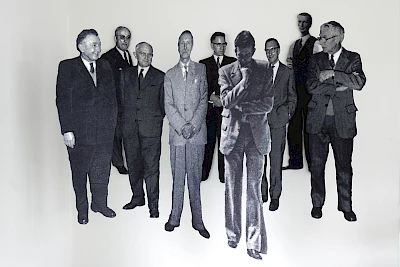Vetus Angelus Novus
| Year: | 2020 |
| City: | Mulhouse and Vienna |
| Measures: | 9 parts, each approx. 95 x 34 cm |
| Media: | Freestanding Embroidery on Canvas |
| Exhibitions: | |
| Projects: | |
| Catalogues: |
Based on photos of the town archive of Mulhouse responsible men of the company DMC from various times are embroidered.
The work connects with Walter Benjamin´s concept of the “Angelus Novus”, the angel of History who looks back despondently at the ruins of the past as he moves forward with the inevitable progress of time:
"A Klee painting named “Angelus Novus” shows an angel looking as though he is about to move away from something he is fixedly contemplating. His eyes are staring, his mouth is open, his wings are spread. This is how one pictures the angel of history. His face is turned toward the past. Where we perceive a chain of events, he sees one single catastrophe which keeps piling wreckage upon wreckage and hurls it in front of his feet. The angel would like to stay, awaken the dead, and make whole what has been smashed. But a storm is blowing from Paradise; it has got caught in his wings with such violence that the angel can no longer close them. This storm irresistibly propels him into the future to which his back is turned, while the pile of debris before him grows skyward. This storm is what we call progress." [1]
This passage demonstrates a moment of hesitation, uncertainty and reflection between moving forwards and looking backwards in time, contemplating the pile of wreckage and suffering at the angels feet. He would like to stay and grow roots on the catastrophe; but his will has been expropriated by the power that forces him to opt for the future against which his back is turned. Benjamins angel of history reveals a greater sense of conflict in the transition between the past and the future then my angels, which appear calm and steadfast.
My Angels are male and embody the gendered foundation of modernity and industrialization. Based on photos of the town archive of Mulhouse responsible men of the company DMC from various times are embroidered. But weather nostalgic, concerned, jovial or hopeful, these men focusing a crucial point of history, stuck in a painful transition between “destruction” and “creation”. They are literally hanging in the air, swaying in the wind, with no way to get hold of their roots. What they know best and could transform has become useless. This sense of uncertainty captured in the angels resonates with the contradictions of post-industrial transition.
Are we still moving into the future backwards, reduced to moving forward while casting desperate glances behind? The tendency to define our time exclusively in opposition to what went before (post-modernist, post-metaphysical, post-industrial) lends credence to the hypothesis and underlines our difficulties in breaking free from a past we claim to have left behind.
If we have no other viewpoint from which to look upon the past than the stance given us by the angels, it seems like an impossible task. The storm blowing from Paradise is still being felt. The angels are still poised the same way. But maybe their stance is merely the result of inertia and the angels have stopped being tragic figures to become puppets in repose.
[1] Benjamin, Walter . 1968. Illuminations . New York: Schocken.













